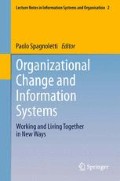Abstract
Recently, the remarkable success of the Cloud Computing inspires reflections related to the introduction and the development of new technologies. The relevant turmoil around this phenomenon is not always supported by a complete understanding of its peculiarities, potentialities, opportunities offered to companies and of its consequent organizational implications. Actual market propositions of Cloud solutions include not only the supply of infrastructures and applications as a service, but also the availability of business platforms, to design business processes and to realize integrated inter-organizational processes. Managers can, in fact, improve their companies productivity and competitiveness through the implementation of Cloud and Business Process Management technologies. This work, through the methodology of multiple case study and the coherent analysis of some providers, is aimed to point out Cloud Computing peculiarities, and different organizational approaches that actually characterize projects’ planning and implementation, to identify, apart from various offer typologies, standardized procedures for process management and to deduce and suggest a common, hoped organizational behaviour.
Although this work is the result of a common will, every paragraph has been written by a single author; particularly:
1st and 2nd sections by Roberto Candiotto.
3rd and 4th sections by Silvia Gandini.
Access this chapter
Tax calculation will be finalised at checkout
Purchases are for personal use only
Notes
- 1.
In short, from now on the term ≪Cloud≫ will be used as ≪Cloud Computing≫.
- 2.
Literature analysis has been realized on the abstracts of 837 chapter, in the years from 2010 to 2011, of these publications: European Journal of Information Systems, Information Systems Journal, Information Systems Research, Journal of AIS, Journal of MIS, MIS Quarterly [first 6 excellence journal and review according to the ranking of Association for Information Systems (AIS)] and Information and Management, Management Science [class A review for ≪Organization≫ area according to the ranking 2011 of Accademia Italiana di Economia Aziendale (AIDEA)]. The analysis has shown that only 9 chapter are related to Cloud topics, and not focused on organizational aspects of ICT as a Service.
The same results has been produced by the analysis of the first 15 available Google Books, related to the keyword ≪Cloud Computing≫, and on the first 20 pages of Google Scholar, related to the same keyword.
- 3.
Source: http://www.nist.gov/.
- 4.
We thank all companies’ managers that have allowed the realization of this work with their willingness, professionalism, attention, and sensitivity. Particularly: for Altea Gian Carlo Pera and Giovanni Rota, for Asystel Danilo Formaggini and Paolo Sito, for Cosmic Blue Team Manuela Branz and Paolo Zanolini, for EID Giuseppe Volta, for Gruppo Zenit Alessandro Barbero and Roberto Pagano, for IBM Mariano Ammirabile and Mario Moccia, for Kelyan Andrea Bouchard and Luca Ferraris.
The interviews has been planned by defining a specific scheme, predisposed through preliminary conversations (May–July 2011), and then realized (October 2011–January 2012).
- 5.
The activation of Cloud solutions requires the availability of the broadband Internet connections, to assure high service levels, and particularly a reliability threshold closed to 99,999 %.
- 6.
A Service Oriented Architecture (SOA) is a set of principles and methodologies for designing and developing software in the form of interoperable services; these services are well-defined business functionalities that are built as software components that can be reused for different purposes. SOA also generally provides a way for consumers of services, such as web-based applications, to be aware of available SOA-based services.
- 7.
For instance, reduction of development and activation costs, solutions’ flexibility, quality of supplied services, new competencies development, etc.
- 8.
These professional figures can be used in a first moment, mainly if final consumers aren’t so ready to have an autonomous access to the provider’s resources.
- 9.
For instance: Cordys, Pega, Appian, HumanWave, Longjump.
References
Chellappa, R. K., & Gupta, A. (2002). Managing computing resources in active intranets. International Journal of Network Management, 12(2), 117–128.
Aymerich, F., Fenu, G., & Surcis, S. (2008). An approach to a cloud computing network. Proceedings of the 1st International Conference on the Applications of Digital Information and Web Technologies.
Ahronovitz, M. et al. (2010). A white paper produced by the cloud computing use case discussion group. Cloud Computing Use Cases, 10.
Avison, D. A., & Pies-Heje, J. (1995). Research in information systems: A handbook for research students and their supervisors. Oxford: Elsevier Butterworth-Heinemann.
Baskerville, R. L., & Myers, M. D. (2002). Information systems as a reference discipline. MIS Quarterly, 26(1), 1–14.
Davis, G. (2000). Information systems conceptual foundations: Looking backward and forward. In R. L. Baskerville, et al. (Eds.), Organizational and social perspectives on information technology. Boston: Kluwer.
Catteddu, D., & Hogben, G. (2009). Cloud computing benefits, risks and recommendations for information security. http://www.enisa.europa.eu/act/rm/files/deliverables/cloud-computing-risk-assessment.
Vaquero, L. M., Rodero-Merino, L., Caceres, J., & Lindner, M. (2009). A break in the clouds: Towards a cloud definition. ACM SIGCOMM Computer Communication Review, 39(1), 50–55.
Armbrust, M., et al. (2010). A view of cloud computing: Clearing the clouds away from the true potential and obstacles posed by this computing capabilities. Communication of the ACM, 53(4), 50–58.
Leavitt, N. (2009). Is cloud computing really ready for prime time? Computer, 42(1), 15–20.
Stamatis, D. H. (2003). Failure mode and effect analysis: FMEA from theory to execution. United States: ASQ Quality Press.
Author information
Authors and Affiliations
Corresponding author
Editor information
Editors and Affiliations
Rights and permissions
Copyright information
© 2013 Springer-Verlag Berlin Heidelberg
About this chapter
Cite this chapter
Candiotto, R., Gandini, S. (2013). Organizations and New IT Paradigms: Processes and Organizational Implications Related to Cloud Computing Projects. In: Spagnoletti, P. (eds) Organizational Change and Information Systems. Lecture Notes in Information Systems and Organisation, vol 2. Springer, Berlin, Heidelberg. https://doi.org/10.1007/978-3-642-37228-5_26
Download citation
DOI: https://doi.org/10.1007/978-3-642-37228-5_26
Published:
Publisher Name: Springer, Berlin, Heidelberg
Print ISBN: 978-3-642-37227-8
Online ISBN: 978-3-642-37228-5
eBook Packages: Business and EconomicsBusiness and Management (R0)

